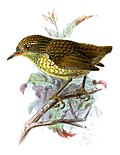| Geositta | |
|---|---|
 | |
| Slender-billed miner (Geositta tenuirostris) | |
| Scientific classification | |
| Kingdom: | Animalia |
| Phylum: | Chordata |
| Class: | Aves |
| Order: | Passeriformes |
| Family: | Furnariidae |
| Genus: | Geositta Swainson, 1837 |
| Type species | |
| Geositta anthoides Swainson, 1838 | |
| Species | |
11, see text | |
Geositta is a genus of passerine birds in the ovenbird family, Furnariidae. They are known as miners (not to be confused with the unrelated miners, Manorina , of Australia) due to the tunnels they dig for nesting. There are 11 species including the campo miner (Geositta poeciloptera) which was formerly classified in a genus of its own, Geobates. They inhabit open country in South America, particularly the Andean and Patagonian regions. They are ground-dwelling birds, somewhat resembling the larks and wheatears of other continents. They are mostly drab brown in coloration and often have a fairly long and slender bill. [1]











